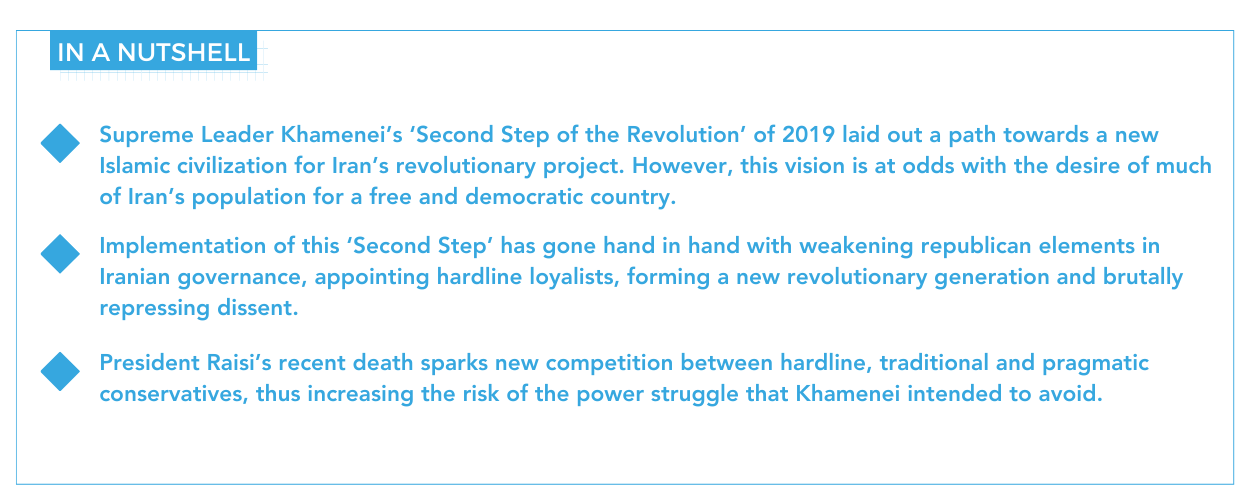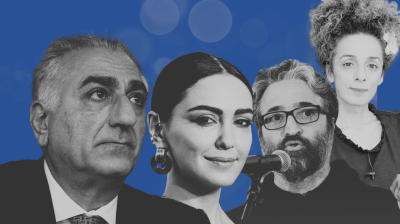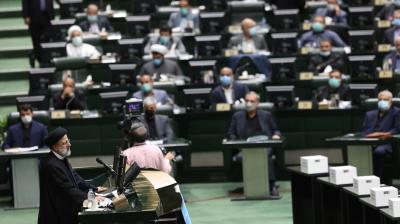How to complete the revolution? Khamenei´s vision and its disruption after Raisi´s death
By Azadeh Zamirirad

Editor’s introduction
In September 2022, the death of Mahsa Amini marked a major turning point for Iran. The event sparked nationwide protests that rapidly evolved from calls to discard controversial hijab regulations to calls to overthrow the Islamic Republic. The Iranian government responded with repression, killing over 400 protesters in late 2022 and early 2023, according to human rights groups.
The Clingendael blog series ‘Iran in transition’ explores power dynamics in four critical dimensions that have shaped the country’s transformation since: state-society relations, intra-elite dynamics, the economy, and foreign relations. This blog post analyzes how the recent death of President Raisi influences Supreme Leader Khamenei’s intention to advance Iran’s revolutionary project by ensuring a smooth succession, placing power in the hands of the country’s hardline conservatives and establishing a new Islamic civilization.
Khamenei´s vision for Iran
In 2019, Ali Khamenei laid out his vision for the future of the Islamic Republic. In a speech marking the 40th anniversary of the 1979 revolution, the Supreme Leader launched the "Second Step of the Revolution" as forward-looking guideline for Iranian policymakers and society as a whole. Khamenei looked back on the first forty years of the Islamic Republic and its accomplishments and outlined a development trajectory for the next four decades. In line with Iranian political discourse, the Supreme Leader views the revolution as an ongoing process that is in need of further advancement. At its core, the Second Step is about passing the ideological foundations and principles of Iran’s revolutionary project to a new generation. This focus is a direct result of the country’s youthful demographics, the massive rift between society and state, and the aging clerical and political elite. The new ‘revolutionary generation’ is expected to accomplish two main aims: to preserve the theocratic order beyond Khamenei´s death and to complete the revolution by creating a "new Islamic civilization" – its ultimate objective.
This new Islamic civilization is based on the notion of an international order in which the ideal of a global Islamic society is finally realized. The concept differs fundamentally from the Westphalian model of sovereign nation-states. Iran’s approach is not state-centered, but faith-based, making religion a defining element of order. The goal is to create a sphere of Islamic sovereignty in which principles of faith can also serve as the basis for international standards and norms. From the perspective of the Supreme Leader, a new Islamic civilization is not synonymous with a global Islamic order and does not necessarily require territorial expansion. It can also emerge as a natural consequence of the spread of Islamic values, thus paving the way for the return of the messianic figure of Mahdi - the 12th and last Imam to be seen as legitimate successor to the Prophet Mohammad by Twelver Shiites (Iran, Iraq, Lebanon etc.). Only under his rule can a true Islamic civilization be fully realized.
According to Khamenei, the new Islamic civilization can be achieved in five stages: (1) an Islamic revolution (enqelabe eslami), (2) the creation of an Islamic order (nezame eslami), (3) the formation of an Islamic government (dolate eslami), (4) the establishment of an Islamic state (keshvare eslami) and finally (5) the realization of an Islamic civilization (tamadone eslami). From Khamenei´s perspective, Iran sits at most between the third and fourth stages. Thus, according to the Supreme Leader, Iran has yet to establish a true Islamic state.
To advance the revolution to its fourth stage, the Second Step essentially requires dismantling the republican features of Iran’s system of government, which will turn the Islamic Republic into an Islamic State. That is to say, a political order in which the source of sovereignty is divine and only divine. Such a state would be characterized by strict adherence to religious rules and practices, including absolute obedience to prevailing dress codes, the ban on alcohol and the allocation of gender roles on the basis of Shia jurisprudence. It would also be devoid of any “Western” influences, especially in the cultural sphere. Khamenei´s political, religious and cultural objectives with regards to Iran as ‘Islamic State’ are reminiscent of similar clerical ambitions in the early days of the Islamic Republic that failed to materialize due to internal divisions and political backlash. The Second step is an attempt to finally enforce what could not be enforced back in the day. Given Khamenei´s vision for Iran, it is no surprise that the Supreme Leader has remained entirely unresponsive to people´s demands for change, which was evident in the state´s response to the "woman, life, freedom" protests of 2022/2023 that were met with brutal repression and tighter legislation regarding dress code.
Republicanism shattered
Khamenei´s vision hinges on the rejuvenation of Iran’s political, social, and military elites to carry on the revolutionary project. His ideal of a new elite is best characterized by the attributes young, revolutionary and ‘hezbollahi’. The new elites are thus ideally born after 1979, subscribe to the ultimate goal of the revolution and do not only follow Shiite beliefs but also take action to advance the revolutionary cause. Being ‘hezbollahi’ means a high level of dedication to Islamic values and showcasing active support for Iran’s theocratic system, ideally through membership in organizations such as the Basij militia.
The Second Step requires personnel replacements in all areas of the state, including parliament, judiciary and the armed forces. Rhetoric notwithstanding, positions have not always been filled with younger people, but rather with more radical ones. It has become clear that the decisive selection criterion is not age, but revolutionary outlook. Appointing political loyalists close to the Supreme Leader is not a new phenomenon in the Islamic Republic, but the extent of Khamenei´s intervention in the political landscape is. This has been most visible in the electoral process.
By democratic standards, Iran has neither free nor fair elections, but for a long time a variety of groups loyal to the system were allowed to compete. As a result, different political camps have formed the government, including hardliners as well as so-called reformers and moderates. This changed after the Second Step was announced and became visible during the 2020 parliamentary elections but especially during the presidential elections of 2021. The elections were won by the politically inexperienced hardliner Ebrahim Raisi, a cleric infamous for his role in the mass executions of political prisoners in the late 1980s and his brutal repression of the “woman, life, freedom” protests.
The circumstances of Raisi's victory were uncommon for the Islamic Republic. The 2021 presidential elections excluded all major political figures from the reformist camp, such as former vice president Eshaq Jahangiri and Mostafa Tajzadeh, as well as well-known figures from the conservative camp, like the long-serving speaker of parliament Ali Larijani. As a result, Raisi ran without a serious opponent. While reformists have been systematically marginalized in previous elections dating as far back as 2009, large parts of both the traditional and pragmatic conservative camp were now sidelined as well. In consequence, loyal hardliners now control all elected and unelected positions of power in the country. By weakening the system’s republican elements and by homogenizing the political landscape, Khamenei hoped to reduce the risk of power struggles once the succession question becomes urgent and ensure an orderly transition.
Popular resistance
However, as the 85-year-old cleric nears the end of his reign, many Iranians are openly questioning the system as a whole. Moreover, they have a revolutionary project of their own. For large parts of Iranian society, the revolution of 1979 has yet to fulfill its original purpose: namely the overthrow of an authoritarian regime to establish a free and democratic nation. While Iran´s leaders seek a transition of power within the existing order, Iran’s people are after its complete transformation. Khamenei’s Second Step widened this gap between society and the state even further, especially for Iran’s younger generation (note that nearly 70 percent of the country’s population was born after the revolution). The "woman, life, freedom" protests were largely carried by members of the Generation Z. Never before in the Islamic Republic did so many young Iranians take to the streets.
But the Iranian state struggled to impose its religious ideals on youth long before the 2022 protests. This has been evident in the widespread consumption of alcohol, a flourishing black market for foreign music and films, and the mass utilization of VPN servers to circumvent internet censorship. The most visible act of defiance, however, has been resistance against the Islamic dress code. The "woman, life, freedom" protests were preceded by four decades of civil disobedience in which Iranian women gradually pushed back against the state. Today, many leave the house without carrying a headscarf, despite rigid legislation and its violent enforcement.
Iranians have also used elections to show their discontent and deny the state legitimacy. Voter turnout has rapidly declined over the years. In the 2021 presidential race, according to official numbers, less than 49% of 59 million eligible voters cast their ballots. During parliamentary elections in 2024 turnout dropped to around 41% nation-wide with run-off elections in May 2024 even falling below 10% in Tehran. For the vast majority of voters, elections are no longer a viable channel for change in social, political or economic matters due to a lack of progress. For years, even so-called reformists and moderate factions of the Iranian elite disappointed the electorate since they proved unable to deliver even minor sociopolitical changes. Under their rule, repression, censorship, restricted freedom of press, discrimination against minorities, systematic oppression of women, torture and executions prevailed just like under hardline governments.
With no electoral path in sight towards substantial change, Iranians turned to more active forms of resistance. Both 2017/2018 and 2019/2020 saw nationwide protests on a large scale, a development not seen since the 2009 Green Movement. While the mass protests in 2009 were mainly attended by the urban middle class and led by reformists, the demonstrations of 2017/2018 and 2019/2020 were largely supported by lower-income households and disconnected from political factions. In September 2022, the death of Mahsa Amini at the hands of the morality police triggered an unprecedented wave of protest and solidarity across the country. For the first time, people of different ages, ethnic backgrounds and social classes took to the streets together.
So far, popular resistance has lacked organizational coherence and a clear agenda for transformation of the political system. However, the “woman, life, freedom” protests have sparked new debates about what strategies to follow and what a future political system should actually look like with some protesters developing new ideas on basic principles and fundamental wants. In 2023, twenty independent organizations including trade unions, student bodies and feminist groups, issued a charter of "minimum demands" that included unconditional freedom of expression and gatherings, full equality of rights between women and men, an end to ethnic and religious discrimination and separation of religion and state. While views on the preferred type of future political order may differ, the desire for a free, secular and democratic state is shared by Iranians who took to the streets.
Raisi’s death: An unexpected stumbling bloc
Since the announcement of the Second Step in 2019, the Supreme Leader has empowered one faction over all others to place political authority in reliable hands in case of his eventual demise. Hardline conservatives have been the main beneficiaries of this approach, while other well-established figures of the conservative camp have been marginalized. Doctrinal positions on rule, lifestyles and governance have become even more rigid.
But what looked like a smooth trajectory to hand over power might now be in jeopardy. The unexpected death of president Raisi, who was killed in a helicopter crash in May 2024, has shaken up the domestic scene. The 2021 elections were specifically tailored to ensure Raisi’s take-over of the presidency, providing him with the political clout to either become the next Supreme Leader eventually, or at least play a pivotal role in ensuring a smooth transition. His death has created a vacuum that others will now be eager to fill. However, given Khamenei´s age, there might not be enough time for grooming another potential successor through the presidency.
With no clear alternative in sight to perform the role Raisi was meant to play, other political factions will seek to regain lost power, notably traditional and pragmatic conservatives. This is bound to reinvigorate the very power struggle Khamenei had hoped to avoid by homogenizing the political landscape in the first place. Moreover, with only weeks to prepare for the upcoming presidential elections, mobilizing voters will be more difficult than ever given that the exercise of this right is broadly viewed as futile by most of the electorate. This is not so much a concern for a system that has essentially given up on the idea of obtaining legitimacy through the ballot box, but it could prove a bigger obstacle further down the road. Despite repeated crackdowns on protests, popular resistance continues in everyday life and calls for fundamental change have not subsided.
Even when discounting popular preferences, it is not clear whether Khamenei’s vision of a new Islamic civilization will remain the regime’s ultimate goal after he is gone. Whoever will rule Iran may choose to redefine his ideological project and prefer a path that is better suited to maintain existing networks of power. Given the political and economic rise of the Revolutionary Guards in recent years, a transition to a military dictatorship is a credible prospect as well. In the end, Raisi´s death was an uncomfortable reminder to Khamenei that no amount of planning can guarantee the smooth process he desires, nor his preferred outcome.
Hamidreza Azizi and Erwin van Veen are the initiators of this blog series.




